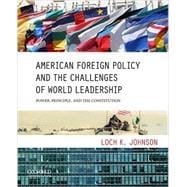In American Foreign Policy and the Challenges of World Leadership: Power, Principle, and the Constitution, preeminent scholar and renowned advisor on national security Loch K. Johnson offers students an insider's portrait of U.S. foreign policy that explores its underlying and driving constitutional principles. Featuring an engaging and accessible writing style, this unique book focuses on the fundamentals of foreign policy--its theory, historical evolution, institutions, and instruments--and offers an in-depth look at the tools that the U.S. uses to defend and advance its interests abroad, including diplomacy, trade, aid, war-making, moral suasion, spying, and covert action. It also shows how the personalities of people who hold high offices and other little-known, behind-the-scenes factors can influence foreign policy. Contemporary issues, including global terrorism, nuclear weapons proliferation, global environmental degradation, world population pressures, and migration issues, are addressed throughout.
FEATURES
Uses a levels-of-analysis approach, highlighting the significance of three levels where foreign policy is shaped: in the international setting, in domestic politics, and at the individual level
Chapter outlines, lists of learning objectives, and lists of key constitutional questions for each chapter help direct students' reading
Brief chapter-opening vignettes highlight historical events of significance to the study of U.S. foreign policy
"Perspectives on American Foreign Policy" text boxes present excerpts from key documents or insights from top experts








